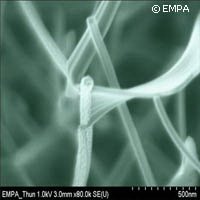Jul 12 2010
Swiss and German materials scientists have created simple networks of organic nanowires for future electronic and optoelectronic components. The successful approach synthesises the complex and incredibly thin nanowire structures, and joins them to electrically conducting links (essentially creating an electronic circuit).
The result is a culmination of work that began in 2006 under the PHODYE ('New photonic systems on a chip based on dyes for sensor applications scalable at wafer fabrication') project, which was funded EUR 1.92 million under the 'Information society technologies' (IST) Thematic area of the EU's Sixth Framework Programme (FP6).

The PHODYE project was initiated by Dr Angel Barranco from the Instituto de Ciencia de Materiales de Sevilla in Spain, who invited his former colleagues from the Swiss Federal Laboratories for Materials Testing and Research (Empa) to become involved. Empa is one of eight academic and industrial partners from four European countries (Belgium, Spain, Sweden and Switzerland) currently working on the project.
The aim is to develop a new family of sensor devices that combines dye sensor films and photonic structures. These incredibly sensitive gas sensors (made up of thin films that change colour and fluoresce on contact with certain gas molecules) could eventually be used to monitor vehicle emissions or to provide warnings of the presence of poisonous substances.
It was during their work on PHODYE that Empa's Ana Borras, Oliver Gröning and Pierangelo Gröning, and Jürgen Köble from Omicron Nanotechnology in Germany created the unique methodology for connecting organic nanowires. The result is a step towards the manufacture of cheaper and more flexible sensors, transistors, diodes, and other components, ranging from the micro all the way to the nano scale.
The physicists developed a new vacuum deposition process for synthesising organic nanowires and discovered how to manufacture nanowires with largely varying characteristics by appropriately selecting the starting molecule and the experimental conditions. Their method is particularly unusual and surprising because it has generated a perfectly monocrystalline structure by precisely controlling the substrate temperature, molecule flow and substrate treatment.
The team soon discovered that the new process was not only able to provide nanowires for the gas sensors needed under PHODYE, but it opened the door to creating complex 'nanowire electric circuits' for electronic and optoelectronic applications (e.g. solar cells).
The reason being that the range of nanowires can be used together (as required) to form networks with broadly varying properties. The secret to this lies in having decorated (using a sputter-coating process) the nanowires growing on the surface with silver nanoparticles. Thanks to these particles, more nanowires can be grown that are in electrical contact with the original wires - the foundation of an electrical circuit on the nanoscale.
Dr Gröning explained that the potential exists for being able to manufacture organic semiconductor materials, which are very attractive candidates for the manufacture of inexpensive, large area and flexible electronic components.
The team has presented the results of their finding in the journal Advanced Materials. The PHODYE project formally concludes in October 2010.
Source: Cordis